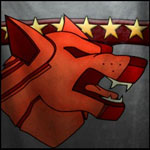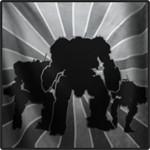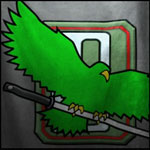 Rekkon, on 23 June 2016 - 12:15 PM, said:
Rekkon, on 23 June 2016 - 12:15 PM, said:
Tank destroyers were usable at range, not so much close up. This is fine for real life armor in suitable terrain, not so much for Battletech where engagement distances are short, unit speeds are high relative to engagement distances and unit durability means they can usually survive to close the range.
A big justification for tank destroyers was cost. Turrets are expensive, so it was cheaper to make an AFV without them. Yes, they allowed you to mount a larger weapon, but that mattered more for chassis where the original turret could no longer accommodate an effective cannon, hence projects like converting Panzer IIIs into StuGs. There were fewer tank destroyers built on platforms that did not go obsolete before the end of the war, like the Panzer IV. Overall, the advantages of a full turret generally outweigh the benefits of going tank destroyer, evidenced by the lack of such designs today where nations have the luxury to focus on "most effective" style vehicles rather than being forced by the conditions of total war to crank out as much of anything usable as possible.
Agreed.
Thing is, in tabletop engagement ranges are short. In Battletech, engagement ranges depended on the pilot. After all, all autocannons could reach out to 2,000 meters. But hitting something "as small and agile as a Battlemech" was considered impractical. Then, despite same ammo types, etc. -- across various brands and models of ACs, such as those created by GM, Armstrong Weaponry, Defiance Industries, Bithinian Ballistics, Sterope Defense Industries, etc.-- the reason that ranges cut for higher classifications of autocannon is actually firing rate. AC/2s are slow, AC/20s are fast. If given the same caliber of ammunition, the AC/20 spits out bullets 10 times faster than an AC/2 and two times and two additional tons the overall weight. (6 tons and 14 tons). Because AC/20s shoot so much faster (4x faster than AC/5s, 2x faster than AC/10s), the AC/20 has horrific range over the other ACs.

Note: Caliber can be high or low in any class of AC. For example a high caliber AC/2 (typically 80-90mm) shoots most of its damage in very few shots while a low caliber (such as the BJ-1's GM Whirlwind/L) is a 30mm AC/2 requiring 10 shots to get the full 2 damage (lore-wise) and according to both the lore, the rules in MaxTech for double firing ACs, and the idea I was churning out in that big post you quoted from, that 30mm AC/2 could fire up to 20 shots at high risk chance for 4 damage. (With the other mentions of splitting damage for weapons in lore that are not front loaded [lasers, ACs] and 1x ratings for all weapons and the lore/maxtech based double fire for all ACs... that damage split isn't so bad and with the max range being 2,000 something meters for almost full-per-shot damage but an accurate long range of 720 meters, where 'snipers' could pull off 1440 meters if skilled and time their shots good as well as compensate for bullet drop. Especially if those sniper-harassers are rewarded with near full damage there. And compared to the lasers given in the example. Very useful. Unlike MWO.
Typically, the mechs that do not have torso twist fulfill one of the following roles:
Locust: Scout.
Jenner: Scout, skirmisher or in one variant's case: Brawler.
Catapult: Fire support.
Nova: Fire support, skirmisher, hunter.
Lack of twist simplifies piloting, making it a bit advantageous for faster mechs as you can focus better on where you are going.
The Jenner couldn't twist, but its "head" is very clearly depicted as being able to rotate as necessary to facilitate use of its stock SRM pack. Note: Standard SRMs do indeed lock as well as fire and forget. It is
Dead-Fire Missiles -- a type of SRM and LRM ammo -- that are dumbfired and MRMs. SRMs aren't superb, but they are guided.
The Catapult's case, well it is a walking field artillery. The extrusions on the knees are meant for the mech to brace, as it actually is so canonically small that its best chance for accuracy is to kneel to fire rather than fire while moving. But being so small and lobbing missiles up and over things, it didn't really matter.

The Nova... as in the many other examples I gave in the post you quoted, would have the ability to flip arms if without lower arm actuators while still being able to pivot arms left and right (regardless of torso twist availability). So while a mech with torso twist might have an arm range of 120 and a twist range of 45 to 90 for a combined field range of 210 degrees with blind spots behind it.. The Nova could have an arm range of 120 in the forward arc, flip arms and have a rear arc of 120, for a combined arc of 240 degrees with blind spots on the sides (where it is weakest in terms of enemies being able to hit it anyway).
Thus... both creating unique dynamics for mechs while keeping them viable and adding some character to them.

Agreed though, you wouldn't want to fight up close for long in any of them, but at least in all cases you'd still have left/right range with the design idea I had in mind (Catapults could aim/lock missiles in any visible direction, Locust has turret in CT and pivotable arms that can flip, Nova has flipping pivoting arms, and Jenner has combined aim/lock and pivoting flipping arms.)

Nothing says a mech without a lower arm actuator can't aim left/right, in fact nothing in BT prevents it. It limits other options, though, such as punching, climbing and makes getting up more difficult. So with it being able to aim left/right and be able to flip behind provided you have upper arm and shoulder actuators intact and functional... nothing says lacking a torso twist has to be a crutch.
Edited by Koniving, 23 June 2016 - 01:14 PM.
 Bradigus, on 23 June 2016 - 07:46 AM, said:
Bradigus, on 23 June 2016 - 07:46 AM, said:




































